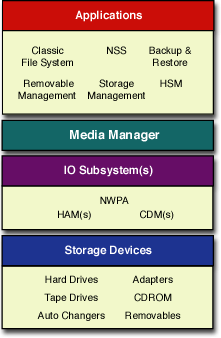1.1 Overview
The Media Manager’s primary responsibility is to normalize the management abstraction of, and access to, the storage devices presented by device driver interfaces (I/O Subsystems).
The Media Manager (MM) exhibits or supports an object oriented design, adopting object oriented philosophies and supporting the notions of classes and objects. MM is indifferent to the classes registered with it or the objects instantiated from those classes. MM provides a default set of classes for typical NetWare usage. This default set, however, can be extended by 3rd party developers to add value to any NetWare 5.x server.
The object-oriented nature of the Media Manager lets the storage environment grow and change without disrupting existing features and applications.
The following sections provide more of an overview of some of the Media Manager Service features:
1.1.1 Environment
The following figure illustrates four distinct sections of the NetWare Storage I/O System environment built to be supported by the Media Manager.
Figure 1-1 NetWare Storage I/O System environment

1.1.2 Applications
An application uses a portion of the MM interface. An application must be registered with MM before using services provided by MM. Other services can be taken advantage of without registering. Applications include:
- Classic file system
- NSS
- Backup and restore
- Removeable media management
- Storage management
- HSM
1.1.3 I/O Subsystems
An I/O subsystem defines and supports a driver interface. The driver interface can be for a particular technology, such as I2O, SCSI, or IDE. Or it can support a number of technologies. MM is independent of the technology at the device level or at the level of the bus that the device connects to. The I/O subsystem creates, in the MM database, device objects which then become available for access or abstraction. Although Media Manager is independent of the I/O subsystem, Novell® currently recognizes and supports only the NetWare Peripheral Architecture (NWPA) as the storage device driver interface.
1.1.4 Storage Devices
The storage devices are the physical storage peripheral, including, but not limited to, host adapters, hard drives, tape devices, auto loaders/changers, removable media (CDROM, CDR, MO, DVD, JAZZ, ZIP, tape, etc.), and RAID solutions. Media Manager is indifferent to the devices supported by the subsystem and yet enables applications to gather information about devices and perform I/O on them.
1.1.5 Pools
We introduced pools, and logical volumes within those pools, for NetWare 6. For compatibility reasons, you can create a volume of a specified size where no pool existed before (which automatically creates a pool with the same name as the volume and creates a logical volume within that pool).
Since there is a one-to-one correlation between logical partitions and pools, the pool size is set to the same size as the logical partition. The logical volume quota size is the size set in the volumeSize element of the configuration dialog that is used to create the volume. If this size is not set (default = zero), the logical volume has no quota.
For NetWare 6, the proper way to create pools and logical volumes is to create the pool by calling MM_POOL_CREATE, passing in the desired name of the pool in the volumeName element of the configuration dialog. (The pool consumes the entire size of the logical partition, so the volume size is ignored.)
Create each logical partition within the pool by calling MM_VOLUME_CREATE. The desired volume name and quota size should be set in the volumeName and VolumeSize elements of the configuration dialog.
Pools can be expanded by calling MM_POOL_EXPAND and adding a new logical partition to the old logical partition.